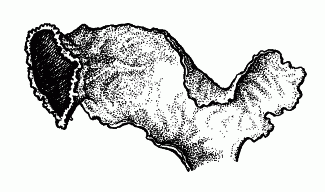Ahtiana pallidula Tuck. ex Riddle
twig bishop
Parmeliaceae
Introduction to the Lichens
twig bishop
Parmeliaceae
Introduction to the Lichens
Map
Distribution of Ahtiana pallidula unavailable
Species Information
General:
Small to large stratified foliose lichens, corticate above and below, sorediate or not, lobes rather closely appressed to semi-erect or erect, short to more often elongate, averaging to 0.5–10 (–12) mm wide, thin to somewhat thick, occasionally bearing protruberant marginal pycnidia or cilia. Upper surface brownish, blackish, or brightly coloured; lower surface coloured alike with upper surface, often lacking rhizines. Medulla white (rarely yellow). Photobiont green. Apothecia located along lobe margins, disc brown or black; spores simple, spherical or ellipsoid, colourless, 8 per ascus.
Notes: Thirty-eight species of Cetraria are reported for North America. Nineteen of these occur in B.C. As presently delimited, Cetraria is a heterogeneous genus. Although several species groups are segregated from it as distinct genera (e.g. Asahinea, Cetrelia, Esslingeriana, Masonhalea, Platismatia and Vulpicida), a number of other species and species groups also deserve generic rank. Recently Hale (1987) transfered some of these to Tuckermannopsis. This disposition, however, seems more nomenclatural than taxonomic and is not followed here. Also not accepted here (pending further study) is the separate genus Allocetraria (Randlane and Saag 1992).
Species description:
Upper surface sometimes partly brownish in exposed localities, but otherwise pale (check sheltered lobes) yellowish or pale greenish AND Medulla white; upper surface yellowish green; soredia absent AND Over bark; lobes proportionately short and broad; apothecia generally present; lower elevations; intermontane.
Comments:
Abnormally pale specimens of C. platyphylla and especially C. orbata might be mistaken for C. pallidula. Neither of the former species, however, are distinctly yellowish green.
Reactions:
Medulla K- or in part K+ yellow and KC+ yellowish or orangish.
Contents:
Atranorin and an unidentified fatty acid.
Source: Lichens of British Columbia
Illustration

If more than one illustration is available for a species (e.g., separate illustrations were provided for two subspecies) then links to the separate images will be provided below. Note that individual subspecies or varietal illustrations are not always available.
Illustration By: Trevor Goward
Habitat and Range
Habitat: Infrequent over conifers, especially Douglas-fir, in open, but somewhat humid, intermontane forests at lower elevations, also rare in maritime forestsWorld Distribution: western N Am, N to BC, S to CA.
Source: Lichens of British Columbia
Status Information
Synonyms
Synonyms and Alternate Names:
Cetraria pallidula Tuck. ex Riddle
Tuckermannopsis pallidula (Tuck. ex Riddle) Hale
